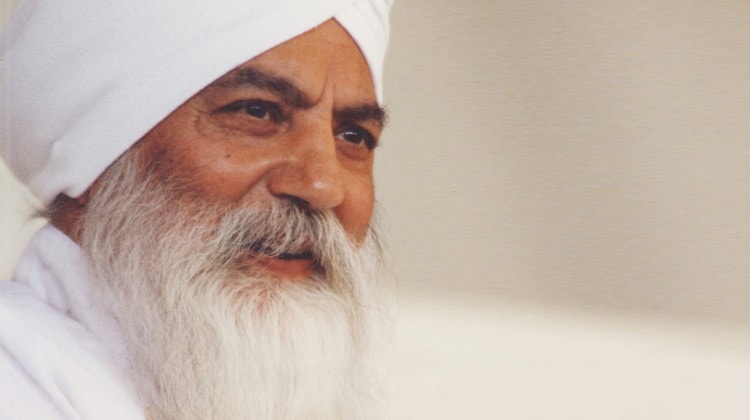Going to a new yoga class can feel intimidating. When I moved from New York City to New Hampshire the closest studio focused on the Kundalini practice, a branch I had never before tried. I was anxious about encountering the unknown, but my curiosity was prodded as I noticed the teachers in training at the local health food store wearing all white, and turbans. They looked like ethereal clouds passing through the smoothie line. I would wonder what Kundalini was like, but was tentative about taking the first step. Even though I had been practicing yoga for over 12 years, I was nervous about trying something new. Eventually a friend of mine persuaded me to go to a class, and life has never been the same since.
A Brief History Of Kundalini
Kundalini was only recently taught to the greater public when Yogi Bhajan (see title photo) brought it to the US in 1969. Prior to that, Kundalini was passed down exclusively from guru to disciple, and each new disciple would devote their lives to the practice. Yogi Bhajan expressed the belief that everyone should benefit from Kundalini and felt that we all have a guru inside of us. That is the divine teacher who is evoked in the beginning of class.
Philosophically, the concept of a guru inside us was appealing. The idea resonated with me that there is an eternal wisdom we all possess which connects us to the energetic intelligence of the universe. Although there is much we can learn from other people, I believe that they are only awakening knowledge we already have if we are open enough to listen. This concept of trusting to my own inner guru was very applicable to life off the mat and I was grateful for this perspective.
What Is Kundalini Like?
The actual physical practice of Kundalini is intense and incorporates the 8 limbs of yoga more than any other practice I have experienced. There are kryas, which are series of asanas that often integrate pranayama and mantra that target specific chakras, mental blockages, or aura cleansing. The kryas are very specific in their intentions of healing the mind and body, and are often repetitive movements, or holding a specific pose for an extended period of time.
Now I am a pretty fit woman. I would consider myself strong, and have good endurance. But everything we do in Kundalini class brings me to a breaking point. No matter what pose, we are always doing it for wayyyyyy longer than I would like. I often hit a wall where my arms feel like they are going to fall off my body if I hold them at a 45-degree angle for one second longer. I curse the teacher and direct all my frustrations towards why she would make me do this for so long. I start to fantasize about throwing her against the wall and then begging her to let it be over. My mind starts to give up and my body wants to follow. But if I focus on the mantra, my breathing, the energy of the class, and the meditation of the movement, somehow I keep going. I remember that I am doing this for a reason, and that reason is a deep internal healing that will benefit me greatly. It is through this determination to continue, and the commitment to stay with it, that elation is birthed. When the pose is over I am so appreciative that my body is flooded with gratitude.
Kundalini Rocked My Ego
I have also been forced to face my ego many times in Kundalini and realize the power it has over me. One example was when the teacher said we were going to get into a “bound lotus” and encouraged everyone to get props. I knew I could get into a bound lotus without props, so I just went right in. The teacher had the class come observe my posture and I felt very proud of myself. A few minutes went by as the rest of the class got themselves settled, and I was starting to really want to come out of the pose. Then the teacher said, “Now that everyone is in the pose, we will hold if for 11 minutes,” and I just about crapped my pants. I had no idea how I was going to be in that position for 11 minutes and wished more than anything that I had gotten props to support me rather than showing off. I barely made it out and was so glad it was over when the teacher said “and now we will do the other side for 11 minutes as well, and make sure to use the same props, or in Toni’s case lack there of, so you are even.”
The Mind / Body Connection
Kundalini is just as much about the mental as it is about the physical. Our bodies are so much stronger than we think, and have so much more wisdom than we understand. It is our minds that hold us back. It is the mind that says “I can’t,” and we have to strengthen our minds just as much as we do our muscles. The more we challenge both the mind and the body in tandem, the deeper their relationship becomes. Kundalini awakens this duality in every class and reminds you that you are in fact a spiritual being having a human experience.
Kundalini is not just for advanced practitioners, and accommodates all body types and levels. The teacher often reminds the class that visualizing yourself doing the poses still has benefits, and the healing potential is immense. You don’t have to be a limber 20-year old former gymnast to enjoy your experience, and people of all ages and capabilities can find a home in this practice. I highly recommend experimenting with Kundalini– no matter what your level or past experience.


